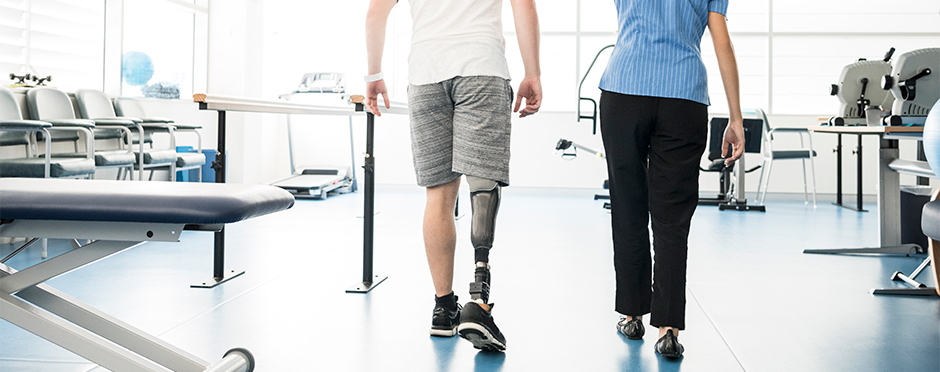
How Physical Therapy Can Help Patients Regain Mobility After Limb Loss
1 CommentNearly 2 million people in the United States live with a major limb loss as a result of illness or trauma.1
Although medical advances in the treatment of cardiovascular disease and diabetes has reduced the need for life-altering amputations, the overall number of those who require lower limb amputations is expected to continue to grow as a result of the growing prevalence of metabolic diseases.2 For those who have suffered limb loss, physical therapy is an important aspect in the restoration of mobility, care of amputee wounds, the management of post-operative pain and the prevention of further injury. Oftentimes those who have suffered limb loss are fitted with a prosthesis, which is an artificial body part. Outpatient physical therapy for post-operative care following limb loss consists of pre-prosthetic and post-prosthetic care. Learn more about prosthetic rehabilitation below.
Pre-Prosthetic Rehabilitation
In pre-prosthetic physical therapy, an Athletico physical therapist (PT) will help patient’s recovery in a number of ways. They will assist in monitoring wound healing and residual limb care in order to prevent excessive swelling or infection, as well as helping to ensure that the residual limb heals to the appropriate shape necessary for use of a prosthetic device. The PT will aid with pain management through soft-tissue desensitization techniques to reduce pain at the surgical site. They will also help to manage phantom limb pain (sense of pain felt in the missing limb) through techniques like mirror therapy. Most importantly, the PT will prescribe exercises, stretching, and other activities that are critical to restoring strength, flexibility, and stability in anticipation of the patient’s first prosthetic limb. While every patient may not be appropriate for a prosthetic, the PT will help the patient achieve the highest level of function and mobility.
A typical pre-prosthetic physical therapy session might look something like this:
- Review of home exercise program to ensure correct form with activities
- Inspection of wound site to ensure healing, with review of compression wrapping techniques for proper shaping of the residual limb
- Stretching and soft tissue mobilization for restoring and maintaining flexibility
- Desensitization and mirror therapy techniques for pain management
- Balance activities for fall and injury prevention
- Strength training for improved leg strength in anticipation of prosthetic training
- Education for foot and wound care to ensure preservation of the uninvolved leg
Post-Prosthetic Rehabilitation
When it comes to post-prosthetic rehabilitation, the PT will work closely with the patient’s surgeon and prosthetist to ensure the new prosthetic device is the appropriate fit and set up correctly for the next stage in the rehabilitation process. After the patient receives their first prosthetic limb, the PT in coordination with the prosthetist will develop a wear schedule for the device to help the patient become accustomed to it.
It is also important to note that the PT will continue to place a high level of importance on care of the patient’s residual limb to ensure that sores do not develop while wearing the prosthetic. The PT will begin training the patient with the device, continuing and expanding upon the activities performed in pre-prosthetic rehabilitation with the end goal of a safe return to daily activities. For the example of a lower limb prosthetic, these activities could including sitting, standing, walking, climbing stairs, and if appropriate, even some higher level activities like running and sports. During this period, a significant amount of time will be spent working on exercises and activities that challenge balance, strength, and gait mechanics, progressing the patient through various forms of assistive devices, from parallel bars, to walkers, to canes, and in many cases, walking without the need of assistance.
Athletico is pleased to offer this prosthetics rehabilitation program in select clinics to patients dealing with recovery after limb loss. If you need pre- or post-prosthetic physical therapy, or if you already have a prosthetic device but need additional training to improve your mobility, click on the link below to schedule an appointment with a nearby Athletico clinic. Our goal is to safely restore your mobility and function and assist your return to an active and independent lifestyle.
The Athletico blog is an educational resource written by Athletico employees. Athletico bloggers are licensed professionals who abide by the code of ethics outlined by their respective professional associations. The content published in blog posts represents the opinion of the individual author based on their expertise and experience. The content provided in this blog is for informational purposes only, does not constitute medical advice and should not be relied on for making personal health decisions.
References:
1. Ziegler-graham K, Mackenzie EJ, Ephraim PL, Travison TG, Brookmeyer R. Estimating the prevalence of limb loss in the United States: 2005 to 2050. Arch Phys Med Rehabil. 2008;89(3):422-9.
2. Driver VR, Madsen J, Goodman RA. Reducing amputation rates in patients with diabetes at a military medical center: the limb preservation service model. Diabetes Care. 2005;28(2):248-53.

1 Comment
Randy Chorvack
It’s cool that education for foot care is included in physical therapy. That means you can be prepared and prevent serious injuries from happening. I think it’s good not only to get stronger but learn ways to keep yourself from getting hurt.